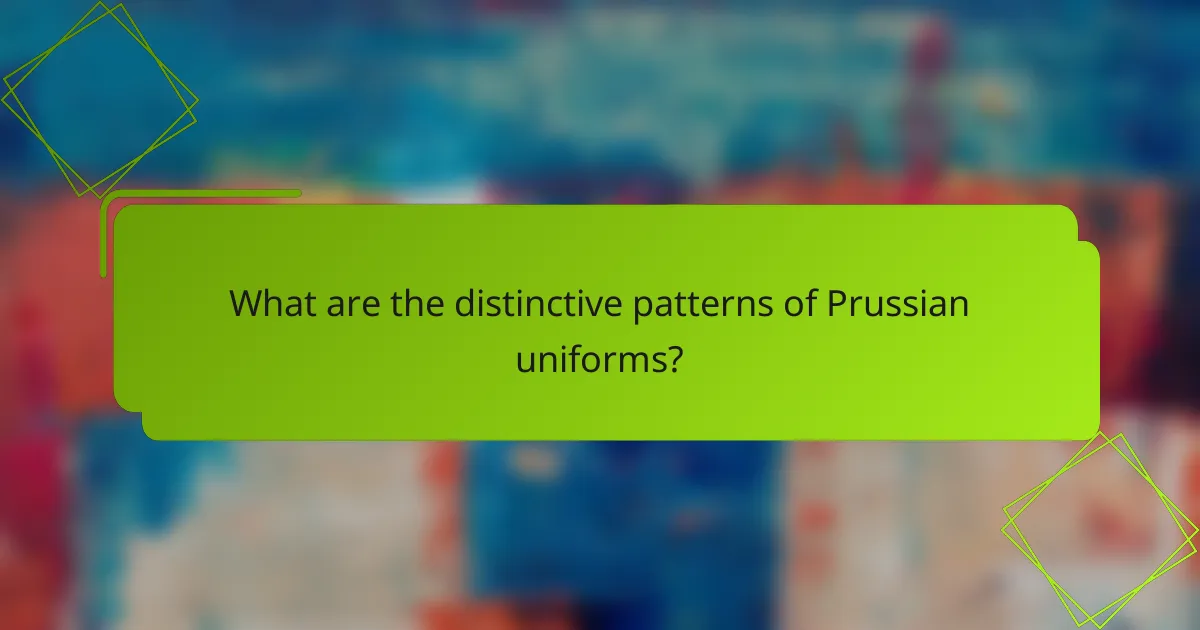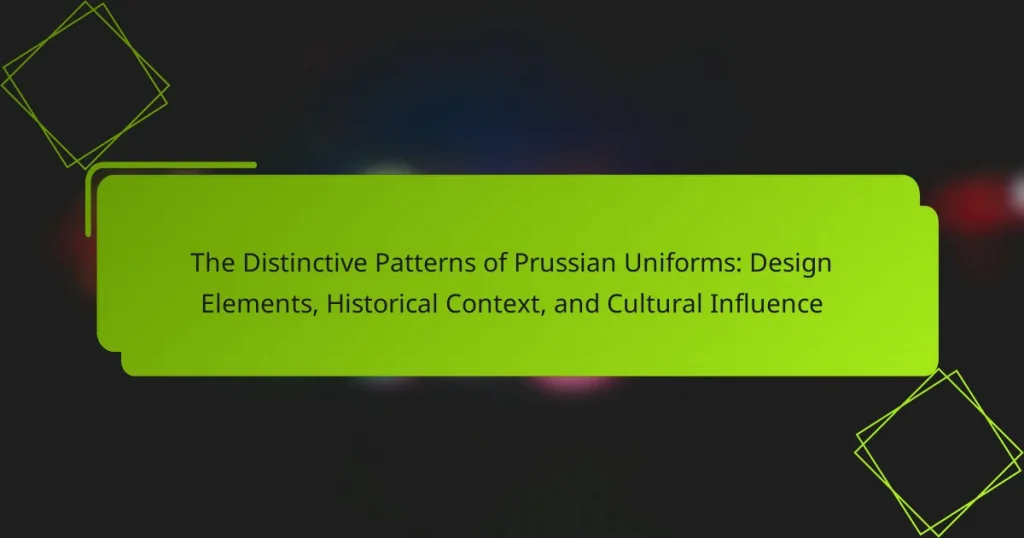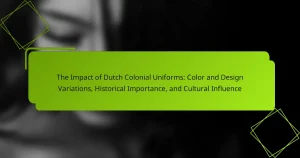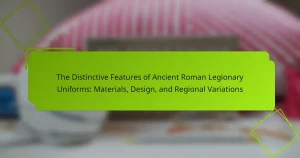Prussian uniforms are a significant aspect of military history, characterized by their dark blue color, fitted design, and distinctive embellishments such as epaulettes and braiding. These uniforms were designed for both functionality and ceremonial display, fostering pride and unity among soldiers. The evolution of Prussian uniforms, including the introduction of the iconic Pickelhaube helmet, reflects changes in military tactics and technology over time. The design elements of these uniforms have not only influenced military fashion in various countries but also continue to be a subject of study in understanding modern military attire.

What are the distinctive patterns of Prussian uniforms?
Prussian uniforms are characterized by their distinct colors, cuts, and embellishments. The primary color associated with Prussian uniforms is dark blue, often complemented by contrasting colors like white, red, or yellow. The cut of the uniforms typically features a fitted design, emphasizing a soldier’s stature. Epaulettes and braiding are common decorative elements on the shoulders and cuffs.
Historically, these uniforms were designed for both functionality and display. The use of specific colors and patterns was meant to instill pride and unity among troops. Additionally, the uniforms evolved over time, reflecting changes in military tactics and technology. Notably, the introduction of the Pickelhaube, a spiked helmet, became an iconic symbol of Prussian military attire.
The distinctive patterns of Prussian uniforms have influenced military fashion in various countries. Their design elements continue to be studied in military history for their impact on modern uniforms.
How did the design elements of Prussian uniforms evolve over time?
The design elements of Prussian uniforms evolved significantly from the late 17th century through the 19th century. Initially, these uniforms featured simple designs with limited color palettes. By the 18th century, distinctive features such as the use of blue fabric became prominent, symbolizing Prussian military identity. The introduction of elaborate decorations, including epaulettes and ornate buttons, marked a shift toward more visually striking uniforms.
During the Napoleonic Wars, practicality influenced design, leading to the adoption of more functional elements. The introduction of the pickelhaube, a spiked helmet, became a unique identifier for Prussian troops. In the mid-19th century, the uniforms began to incorporate elements of military fashion, such as tailored cuts and a variety of materials.
The evolution continued with the adoption of the Krümpersystem in 1860, which standardized uniform design for efficiency. By the end of the 19th century, uniforms reflected both military tradition and contemporary fashion trends, showcasing the dynamic nature of Prussian military attire.
What specific colors and patterns were commonly used in Prussian uniforms?
Prussian uniforms commonly featured dark blue and gray colors. The dark blue was primarily used for the infantry, while gray became prominent in later periods. Red was frequently used as an accent color, particularly in cuffs and collars. The patterns often included simple, clean lines without excessive ornamentation. The use of brass buttons was typical, adding a metallic contrast to the fabric. These design choices were influenced by military practicality and the need for uniformity in ranks. Historical records indicate that these colors and patterns contributed to the distinct identity of the Prussian military.
How did the materials and craftsmanship influence the design of these uniforms?
The materials and craftsmanship significantly influenced the design of Prussian uniforms. High-quality wool and cotton were commonly used for durability and comfort. These materials allowed for intricate tailoring and fitted designs. The craftsmanship involved precise stitching and detailed embellishments. This attention to detail enhanced the uniforms’ visual appeal. Additionally, the use of brass buttons and metal insignia added a distinct character. Historical context shows that these design elements reflected military pride and discipline. Overall, the combination of superior materials and expert craftsmanship defined the unique style of Prussian uniforms.
What historical context shaped the development of Prussian uniforms?
The development of Prussian uniforms was shaped by military reforms and the need for modernization. In the early 19th century, Prussia faced military defeats that highlighted the need for improved organization and discipline. The introduction of the Krümpersystem in 1806 emphasized rapid troop mobilization and standardization of uniforms. This system influenced the design, leading to simpler, more functional attire. Additionally, the influence of the Napoleonic Wars prompted Prussia to adopt a more distinctive and recognizable uniform style. Uniforms became a symbol of national pride and military efficiency. The creation of the Prussian General Staff further emphasized the importance of uniforms in establishing a professional military image.
How did military conflicts impact the design and adoption of Prussian uniforms?
Military conflicts significantly influenced the design and adoption of Prussian uniforms. The Napoleonic Wars prompted the Prussian military to modernize its uniforms for practicality and efficiency. This led to the introduction of simpler designs that allowed for ease of movement. The need for camouflage became apparent during conflicts, resulting in darker colors and more functional materials. The wars also emphasized the importance of distinguishing ranks through uniform variations. Innovations in fabric and tailoring emerged as a response to the demands of warfare. Furthermore, the success of the Prussian military in these conflicts set a precedent for uniform standards adopted by other nations. Overall, military conflicts drove the evolution of Prussian uniforms, reflecting both tactical needs and national identity.
What role did political changes play in the evolution of these uniforms?
Political changes significantly influenced the evolution of Prussian uniforms. The uniforms evolved to reflect shifts in military strategy and national identity. For instance, the unification of Germany in 1871 led to standardized military attire, promoting a sense of national unity. Additionally, the rise of different political regimes prompted changes in color schemes and insignia. Under the leadership of various monarchs, the uniforms adopted styles that symbolized their respective ideologies. The introduction of modern warfare tactics also necessitated functional adaptations in uniform design. Historical events, such as the Franco-Prussian War, further shaped the aesthetic and practical aspects of these uniforms. Consequently, political changes directly impacted the visual representation of military power and national pride through uniform evolution.
How did cultural influences affect Prussian uniform designs?
Cultural influences significantly shaped Prussian uniform designs. The military uniforms reflected the values and aesthetics of Prussian society. For example, the use of specific colors like blue and white symbolized loyalty and purity. Additionally, the adoption of elements from various European military traditions showcased Prussia’s desire to project power and prestige. The incorporation of distinct insignia represented rank and unit affiliation, influenced by historical military practices. Furthermore, the designs were often inspired by the ideals of the Enlightenment, emphasizing discipline and order. Historical context reveals that these uniforms were not just functional but also a statement of national identity. The evolution of these designs mirrored shifts in cultural attitudes, particularly during times of reform and modernization in the 19th century.
What cultural symbols were incorporated into the design of Prussian uniforms?
Prussian uniforms incorporated several cultural symbols, reflecting military tradition and national identity. The colors blue and gold were prominent, symbolizing loyalty and valor. The eagle emblem represented the Prussian state and its sovereignty. Additionally, the use of the Pickelhaube, a spiked helmet, became a distinctive feature of Prussian military attire. These elements combined to create a visual representation of Prussian pride and discipline. The design choices were influenced by historical events, reinforcing the military’s role in shaping national identity.
How did social perceptions of military service influence uniform designs?
Social perceptions of military service significantly influenced uniform designs by reflecting societal values and ideals. Uniforms often symbolized honor, discipline, and patriotism. During the 19th century, the Prussian military embraced these perceptions, leading to the adoption of distinctive and elaborate designs. For instance, the use of bold colors and intricate embellishments showcased pride in service. Additionally, uniforms were designed to instill a sense of unity and identity among soldiers. The public’s admiration for military service further encouraged these design choices, as they aimed to project strength and professionalism. Historical events, such as wars and national celebrations, also shaped the evolution of uniform styles. Overall, uniform designs evolved in response to changing social attitudes towards military service, reinforcing their significance in society.
What are the key characteristics of Prussian uniforms today?
Prussian uniforms today are characterized by their historical design elements and distinctive color schemes. They typically feature a dark blue or black base, reflecting the traditional Prussian military style. The uniforms often include brass buttons and epaulettes, which signify rank and add to the formal appearance. Additionally, they may incorporate elements such as high collars and tailored cuts, emphasizing discipline and order. The use of specific insignia and regimental colors is also common, representing various units within the Prussian military tradition. These characteristics are rooted in the uniforms worn by the Prussian army during the 19th century. The adherence to these design elements maintains a connection to the historical legacy of Prussia.
How are historical patterns of Prussian uniforms preserved in modern military attire?
Historical patterns of Prussian uniforms are preserved in modern military attire through design elements such as color schemes, cut, and insignia. Many modern armies incorporate the deep blue and gray colors that were characteristic of Prussian uniforms. The tailored silhouette and structured cuts of these uniforms influence contemporary military fashion. Insignia styles, including epaulettes and rank markings, echo historical designs. Specific examples include the adoption of the Pickelhaube helmet shape in various forms. Additionally, ceremonial uniforms often reflect Prussian aesthetics, maintaining traditional elements. Historical military academies continue to use Prussian-inspired uniforms for their cadets. These design choices highlight the lasting impact of Prussian military heritage on modern military attire.
What role do reenactments and historical societies play in maintaining the legacy of Prussian uniforms?
Reenactments and historical societies play a crucial role in preserving the legacy of Prussian uniforms. They create immersive experiences that educate the public about Prussian military history. Participants in reenactments often wear authentic reproductions of uniforms. This practice promotes interest in historical accuracy and craftsmanship. Historical societies curate collections of original uniforms and artifacts. They also organize events that highlight the significance of these uniforms. Through lectures and exhibitions, they share knowledge about the cultural impact of Prussian military attire. Overall, these activities foster appreciation for the historical context and design elements of Prussian uniforms.
What practical tips can be applied when studying Prussian uniforms?
To study Prussian uniforms effectively, focus on primary sources and historical texts. Examine original documents, illustrations, and photographs to gain accurate insights. Analyze the materials used in the uniforms, such as wool and leather, for authenticity. Compare different regimental uniforms to understand variations in design and insignia. Utilize museum collections and archives for firsthand examples. Attend lectures or workshops on military history to enhance understanding. Join online forums or groups dedicated to military uniforms for shared knowledge. These strategies provide a comprehensive approach to studying the unique attributes of Prussian uniforms.
The main entity of the article is Prussian uniforms, which are characterized by distinct colors, cuts, and embellishments. The article explores the evolution of these uniforms from the late 17th to the 19th century, highlighting the influence of military conflicts, political changes, and cultural symbols on their design. Key features include the use of dark blue and gray colors, tailored cuts, and decorative elements like epaulettes and brass buttons. The article also discusses how historical patterns are preserved in modern military attire and the role of reenactments and historical societies in maintaining the legacy of Prussian uniforms. Practical tips for studying these uniforms are provided to enhance understanding of their unique attributes.




